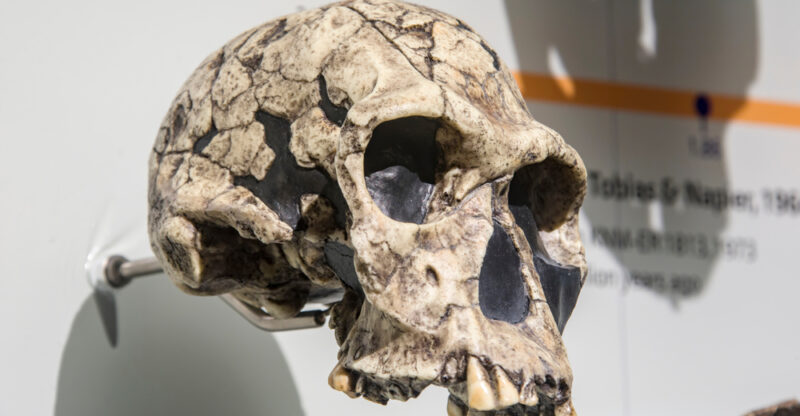We explain what Homo erectus was, where it originated, and what its characteristics were. In addition, we discuss its importance and extinction.

What is Homo erectus?
Homo erectus is the scientific name of a species of the genus Homo, i.e. a hominid belonging to a phase of human evolution. The name Homo erectus comes from Latin, meaning "upright man" or "standing man".
The genus Homo erectus originated about 1.5 million years ago, and became extinct roughly 500,000 years ago. Comprising several species, it inhabited Africa, Asia, and Europe. The oldest fossil remains were discovered in Africa, dating back 1.5 million years.
Upon the initial discovery of its fossil remains, researchers believed it was the first species to have walked upright. However, later finds of Homo habilis and Australopithecus afarensis fossils revealed these hominids had an upright posture in stages of evolution preceding Homo erectus.
- See also: Human origin
Origin of Homo erectus
The earliest Homo erectus fossils were found in Africa, dating back 1.5 million years. Homo erectus populations later migrated to Europe and Asia. Researchers estimate that this population movement could have occurred about one million years ago.
However, the exact dating of many archaeological sites remains unknown, so its precise origin continues to be a matter of debate still to this day.
Characteristics of Homo erectus

The primary physical features distinguishing Homo erectus from its ancestor, Homo habilis, include:
- Brain size. Cranial capacity ranged from 850 to 1,100 cc (61 cu in) among the different species of Homo erectus.
- Body size. Males reached 5 ft 9 in (1.8 m) in height while females were about 4 ft 9 in (1.5 m) tall.
- Cranial structure. The skull was long and low, slightly flattened at the front and back, with bone thickness exceeding that of early hominids.
- Facial structure. The face was short and flat, with a forward-projecting nasal aperture, suggesting the emergence of the distinct human nose with downward-facing nostrils.
Importance of Homo erectus
This genus exhibited a series of adaptations and behavioral modifications, marking it as a crucial phase in human evolution. Homo erectus was the first hominid species to have:
- Migrated out of Africa.
- Hunted regularly and incorporated meat as a primary food source.
- Established camps or built temporary shelters.
- Systematically crafted tools.
- Mastered the use of fire.
- See also: Human evolution
Diet of Homo erectus

Though it is still a point of controversy, most researchers agree that Homo erectus would have hunted small animals, even if for a long time they maintained scavenging habits (consuming animals already killed by other predators).
Certain species belonging to the genus Homo erectus are thought to have mastered the use of fire. However, it remains uncertain whether it was used for cooking.
Homo erectus society
Homo erectus would have handled certain lithic (stone) technology for making weapons (axes, spears, knives) most likely used in the hunting of large animals. These tools became progressively less rudimentary as the species evolved.
Homo erectus were the first hominids to hunt animals, and combined meat consumption with gathering. This has been suggested by various specialists based on material remains found at Olduvai, Tanzania, and Koobi Fora, Kenya sites.
While thousands of animal bones and stones have been found at these sites, the interpretation of the finds remains debated. Some suggest that they are evidence of camps where groups shared food.
Java Man
The name given to the first Homo erectus was "Java Man", due to its discovery on the Java Island, Indonesia, in 1891.
Its discoverer was Dutch anatomist Eugène Dubois, who initially named it Anthropopithecus erectus, but later renamed it Pithecanthropus erectus.
Subspecies of Homo erectus
The subspecies of Homo erectus known to the present day are:
- Homo erectus erectus or Java Man
- Homo erectus pekinensis or Peking Man
- Homo erectus soloensis or Solo Man
- Homo erectus latianensis or Latian Man
- Homo erectus nankinensis or Nanking Man
- Homo erectus yuanmouensis or Yuanmou Man
Additionally, some fossils initially classified as distinct species are now suspected to be variants of Homo erectus, such as:
- Homo (erectus) ergaster
- Homo (erectus) palaeojavanicus or Meganthropus
- Homo (erectus) tautavelensis or Tautavel Man
Archaeological sites of Homo erectus
Homo erectus was the first hominid genus to leave Africa and populate the continents of Asia and Europe. Among the main archaeological sites where fossil remains and materials of Homo erectus populations have been found are:
- Africa. Koobi Fora and Nariokotome (Kenya), Olduvai and Laetoli (Tanzania), Awash (Ethiopia), and Ternifine (Algeria).
- Europe. Dmanisi (Georgia).
- Asia. Sangiran and Trinil (Java), Lantian and Zhoukoudian (China).
Extinction of Homo erectus
Around 500,000 years ago, Homo erectus began to evolve into archaic forms of Homo sapiens. Archaeological finds indicate parallel developments across various regions in different parts of the world inhabited by Homo erectus.
Hence, experts usually refer to a broader hominization process, which culminated in the gradual appearance of larger, more rounded skulls, leading to the eventual extinction of Homo erectus.
Explore next:
References
- Lewin, R. (1994). Evolución humana. Biblioteca Científica Salvat. Vázquez, R. (1992). Homo erectus: Origen y migración a Asia. Cuadernos de Antropología, 8, 91-103.
- Cela Conde, C. J., & Ayala, F. J. (2013). Evolución Humana. El camino hacia nuestra especie. Alianza Editorial.
- Harris, M. (1981). Introducción a la antropología general. Alianza.
- “Homo erectus”. Wikipedia.
- “Homo erectus erectus”. Wikipedia.
- “¿Fue el ‘Homo erectus’ la primera especie capaz de navegar con éxito?”. El Español.
- “Homo erectus”. Dinosaurios.info.
- “Homo erectus – características – hominidos”. Historia y Biografías.
- “Homo erectus”. Smithsonian National Museum of Natural History.
Was this information useful to you?
Yes NoThank you for visiting us :)